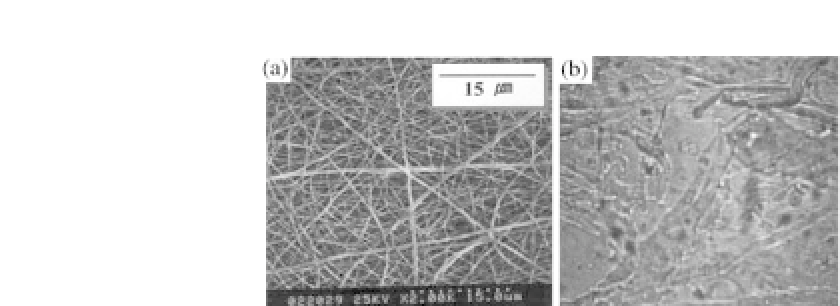Biomedical Engineering Reference
In-Depth Information
Figure 12.4.
PU wound dressings: (a) representative SEM image of
PU wound dressing prepared by electrospinning; (b) photograph of
Tegaderm
TM
(
×
200). Reprinted from Ref. 14 with permission from John
Wiley & SonsInc.
polymers have been explored for skin tissue engineering; however,
the use of these biomaterials as nanofibers has been very lim-
ited. Recently, researcher developed silk fibroin nanofiber matri-
ces by electrospinning for skin tissue engineering.
17
Due to
their high porosity and high surface-area-to-volume ratio, fibroin
nanofibers coated with type I collagen were found to promote ker-
atinocyte/fibroblast adhesion and spreading. Therefore, silk fibroin
nanofibers show potential to be developed as a scaffold for skin
tissue engineering. Khil
et al.
14
,
18
studied polyurethane (PU) elec-
trospun nanofiber matrices for the purpose of wound dressings
(Figs. 12.4 and12.5).
PU nanofiber matrices provided excellent oxygen permeability
and controlled water evaporation. By virtue of these properties, the
matrices allowed fluid from the wound to exude, while prevent-
ing dehydration of the wound. Further, the ultrafine porosity of the
matrices disallowed invasion by exogenous microorganisms. These
results indicated that PU nanofiber matrices showed potential to be
developed as wound-dressingmaterials.
12.3.2
Blood Vessel (Vascular and Cardiac) Grafts
Vascular grafts are in large demand for coronary and peripheral
bypass surgeries. Although synthetic grafts have been developed,
replacement of vessels with purely synthetic polymeric conduits
often leads to the failure of such grafts, especially in grafts less than








Search WWH ::

Custom Search